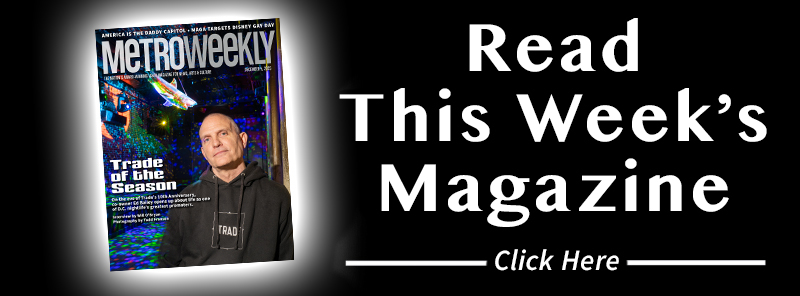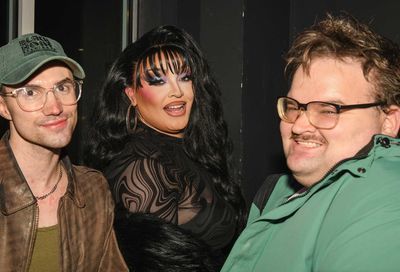Power Walking
Organizers hope the 20th annual AIDS Walk will exceed expectations in money and participation
As the D.C. AIDS Walk took its first steps on the Washington Mall in the spring of 1987, Pat Hawkins and the 100 or so other walkers didn’t know what to expect. The AIDS epidemic had inspired fear, loathing and hatred in the city and around the nation. Whitman-Walker Clinic every week received hate mail — real hate mail, the kind with human excrement smeared inside the envelope.
One can imagine a certain hesitancy. Or, for those who were there, remember it.
”It’s hard to put yourself back in that time frame,” says Hawkins. ”There was still a tremendous amount of fear and discrimination.”
 Carrying the banner at the 2005 AIDS Walk (Photo by Todd Franson/file photo) |
Hawkins, Whitman-Walker’s associate executive director for policy and external affairs, first volunteered for the clinic’s AIDS programs in 1983. She joined the board of directors in 1987 and the full-time staff in 1989. She’s one of a number of people who were on-hand for the first AIDS Walk, an annual fundraiser that will take to D.C.’s streets for the 20th time this Saturday, Oct. 7.
Over the two decades leading up to this weekend’s event, the AIDS Walk has undergone a number of changes in both size and fortune. From that first year on the Mall in the late 1980s, the Walk grew into a massive annual march drawing nearly 25,000 participants during the 1990s. While attendance declined during the latter half of the decade — the result, many organizers and activists believe, of a combination of activist fatigue and HIV treatment success — the biggest blow came in 2001, when the 9/11 terrorist attacks drastically undercut AIDS Walk’s participation.
But there was even some good to find in that, from Hawkins’s perspective. ”We were the first public event on the Mall after 9/11. It was kind of small like the first one was, and probably the most committed people. They weren’t risking the prejudice, but many felt they were risking their personal safety, yet they came out and they made that statement.”
Since that low point in participation and fundraising, the AIDS Walk has resurged over the past few years, once again serving as Whitman-Walker’s largest single fundraiser. David Mallory, the clinic’s associate director of special events, says this year’s event is on track to meeting — and exceeding — the 2006 goal of $500,000 in gross revenues. About 400 teams have registered to participate, 70 more than at this point last year.
”Things are going incredibly well,” says Mallory, who touts the clinic’s community outreach efforts for the event. He’s particularly enthusiastic about the growing participation by teams of students from local high schools and college.
Over the years, the perception of AIDS Walk as a primarily gay event for HIV/AIDS fundraising and awareness has changed as participation by other groups has increased and participation by the GLBT community has, by some accounts, decreased.
”Certainly, participation in the event kind of mirrors what’s going on in the broader community,” says Mallory. ”If [HIV/AIDS] isn’t quite on the front burner for the GLBT community, that’s reflected in the participation in the event. But a good portion of our teams are LGBT or [from] LGBT-supportive organizations.”
The clinic itself has also found itself answering questions about its commitment to serving the GLBT community after more than a year of financial turmoil left the organization re-examining its programs and structure. Spokesperson Kim Mills says that the clinic’s self-appraisal does not affect its core mission.
”We haven’t changed our mission,” she says, noting that the clientele of the clinic has changed as the demographics of HIV/AIDS in the area has changed. ”The clinic has a mission to serve people living with HIV and to serve the GLBT community. That remains the focus of our work.”
Mills says the current financial state of the clinic is good. ”We have cash reserves, we’re paying our bills on time, we invoicing our funders on time. But most important of all, we’re treating more clients.”
The money raised by AIDS Walk will fund Whitman-Walker’s general AIDS programs, says Mallory, including prevention, treatment, testing and other related services. It’s also one of the largest HIV/AIDS public awareness events in the city. The exact prevalence of HIV in the district isn’t known, but based on estimates from the Centers for Disease Control, Whitman-Walker estimates about 18,000 to 25,000 district residents are infected.
Based on year-end statistics from 2004, which showed the district with 9,110 cases of AIDS — as opposed to HIV infection — the local epidemic disproportionately affects the African-American community, which accounts for 82 percent of AIDS cases.
That’s one of the reasons the composition of the AIDS Walk has changed over the decades from the first march, which, says Hawkins, was predominately white and gay. But that first walk engendered a response better than many of them perhaps expected, from tourists on the Mall voicing support to the number of people who actually made contributions.
Also at the first AIDS Walk was long-time Whitman-Walker volunteer Glenda Hardison. Now retired, the then-college administrator had gotten involved in AIDS issues through her church at the time, St. Augustine’s Episcopal, and the formation of Episcopal Caring Response to AIDS (ECRA).
Hardison, who taught Sunday school, decided to take the kids — ranging from little kids to young teens — to the first AIDS Walk. One parent objected, but Hardison says she believes all the children came with her for that springtime march.
”I don’t know what the children expected, or what I expected,” she says. ”But it was a real positive feeling to do something that showed we cared.”
Hardison says that while the crowd that year ”didn’t seem massive,” she was far from disappointed. ”I’ve always been very much an optimist.”
Hawkins and Hardison have both marched in every AIDS Walk since the beginning. Hawkins will be there once again this year, while Hardison is trying to get back from a family trip to Arizona in time to participate, although a recent hip surgery will keep her from walking the route.
While AIDS Walk has changed over the years, it’s maintained an emotional connection for Hawkins.
”Every time, you see people with AIDS out there marching, you see all these people coming together, and they are caring people,” she says. ”It’s a moving march, kind of like a walking quilt in some ways.
The 20th annual AIDS Walk begins with a 9 a.m. rally Saturday, Oct. 7, at Freedom Plaza, 14th Street and Pennsylvania Avenue NW. The 5K walk steps off at 9:30 a.m.
Support Metro Weekly’s Journalism
These are challenging times for news organizations. And yet it’s crucial we stay active and provide vital resources and information to both our local readers and the world. So won’t you please take a moment and consider supporting Metro Weekly with a membership? For as little as $5 a month, you can help ensure Metro Weekly magazine and MetroWeekly.com remain free, viable resources as we provide the best, most diverse, culturally-resonant LGBTQ coverage in both the D.C. region and around the world. Memberships come with exclusive perks and discounts, your own personal digital delivery of each week’s magazine (and an archive), access to our Member's Lounge when it launches this fall, and exclusive members-only items like Metro Weekly Membership Mugs and Tote Bags! Check out all our membership levels here and please join us today!
























